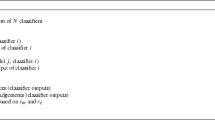Abstract
One of the subfields of artificial intelligence (AI) technology is machine learning. The basic goal is to develop robots that can learn in the same way that humans can. “Learning” here refers to seeing, comprehending, and denoting facts regarding a statistical phenomenon. Synonyms for “learning” include “observe,” “represent information,” and “understand some statistical phenomena.” Swarms of bio-inspired robots cover a wide range of dynamics and collective behaviors. The categorization of swarm behavior from given certain agent measurements of a swarm at a specific time instance is a significant challenge. In reality, only a few agents’ data are available, resulting in minimal agent samples for classification. We solve these issues in this study by applying machine learning to represent a swarm’s collective movements. We apply various machine learning algorithms to classify the swarm behavior in terms of flocking, aligned and grouped, or non-flocking, non-aligned, and non-grouped.
Access this chapter
Tax calculation will be finalised at checkout
Purchases are for personal use only
Similar content being viewed by others
References
Khullar, V., Tiwari, R.G., Agarwal, A.K., Dutta, S.: Physiological signals based anxiety detection using ensemble machine learning. In: Cyber Intelligence and Information Retrieval, pp. 597–608. Springer, Singapore (2022)
Tiwari, R.G., Agarwal, A.K., Kaushal, R.K., Kumar, N.: Prophetic analysis of bitcoin price using machine learning approaches. In: 2021 6th International Conference on Signal Processing, Computing and Control (ISPCC), pp. 428–432. IEEE (2021)
Khullar, V., Ahuja, S., Tiwar, R.G., Agarwa, A.K.: Investigating efficacy of deep trained soil classification system with augmented data. In: 2021 9th International Conference on Reliability, Infocom Technologies and Optimization (Trends and Future Directions) (ICRITO), pp. 1–5. IEEE (2021)
Agarwal, A.K., Tiwari, R.G., Khullar, V., Kaushal, R.K.: Transfer learning inspired fish species classification. In: 2021 8th International Conference on Signal Processing and Integrated Networks (SPIN), pp. 1154–1159. IEEE (2021)
Chhabra, R., Verma, S., Rama Krishna, C.: A survey on driver behavior detection techniques for intelligent transportation systems. In: 2017 7th International Conference on Cloud Computing, Data Science & Engineering—Confluence, pp. 36–41. IEEE (2017)
Osarogiagbon, A.U., Khan, F., Venkatesan, R., Gillard, P.: Review and analysis of supervised machine learning algorithms for hazardous events in drilling operations. Process Saf. Environ. Prot. 147, 367–384 (2021)
Baturynska, I., Martinsen, K.: Prediction of geometry deviations in additive manufactured parts: comparison of linear regression with machine learning algorithms. J. Intell. Manuf. 32(1), 179–200 (2021)
Wang, P., Fan, E., Wang, P.: Comparative analysis of image classification algorithms based on traditional machine learning and deep learning. Pattern Recogn. Lett. 141, 61–67 (2021)
Tunstrøm, K., Katz, Y., Ioannou, C.C., Huepe, C., Lutz, M.J., Couzin, I.D.: Collective states, multistability and transitional behavior in schooling fish. PLoS Comput. Biol. 9(2), e1002915 (2013)
Katz, Y., Tunstrøm, K., Ioannou, C.C., Huepe, C., Couzin, I.D.: Inferring the structure and dynamics of interactions in schooling fish. Proc. Natl. Acad. Sci. 108(46), 18720–18725 (2011)
Brown, D.S., Goodrich, M.A.: Limited bandwidth recognition of collective behaviors in bio-inspired swarms. In: Proceedings of the 2014 International Conference on Autonomous Agents and Multiagent Systems. International Foundation for Autonomous Agents and Multiagent Systems, pp. 405–412 (2014)
Brown, D.S., Kerman, S.C., Goodrich, M.A.: Human-swarm interactions based on managing attractors. In: Proceedings of the 2014 ACM/IEEE International Conference on Human-Robot Interaction, pp. 90–97. ACM (2014)
Wagner, G., Choset, H.: Gaussian reconstruction of swarm behaviour from partial data. In: 2015 IEEE International Conference on Robotics and Automation (ICRA), pp. 5864–5870. IEEE (2015)
Balzano, L., Recht, B., Nowak, R.: High-dimensional matched subspace detection when data are missing. In: International Symposium on Information Theory (ISIT), pp. 1638–1642. IEEE (2010)
Balzano, L., Nowak, R., Recht, B.: Online identification and tracking of subspaces from highly incomplete information. In: 48th Annual Allerton Conference on Communication, Control, and Computing (Allerton), pp. 704–711. IEEE (2010)
Mardani, M., Mateos, G., Giannakis, G.: Rank minimization for subspace tracking from incomplete data. In: 2013 IEEE International Conference on Acoustics, Speech and Signal Processing (ICASSP), pp. 5681–5685. IEEE (2013)
Azizyan, M., Singh, A.: Subspace detection of high-dimensional vectors using compressive sampling. In: Statistical Signal Processing Workshop (SSP), 2012 IEEE, pp. 724–727. IEEE (2012)
Krishnamurthy, A., Azizyan, M., Singh, A.: Subspace learning from extremely compressed measurements. arXiv preprint arXiv:1404.0751 (2014)
Abpeikar, S., Kasmarik, K., Barlow, M., Khan, M.: Swarm behaviour data set. UCI Machine Learning Repository. https://archive.ics.uci.edu/ml/datasets/Swarm+Behaviour
Author information
Authors and Affiliations
Corresponding author
Editor information
Editors and Affiliations
Rights and permissions
Copyright information
© 2023 The Author(s), under exclusive license to Springer Nature Singapore Pte Ltd.
About this paper
Cite this paper
Tiwari, R.G., Yadav, S.K., Misra, A., Sharma, A. (2023). Classification of Swarm Collective Motion Using Machine Learning. In: Bhattacharyya, S., Banerjee, J.S., Köppen, M. (eds) Human-Centric Smart Computing. Smart Innovation, Systems and Technologies, vol 316. Springer, Singapore. https://doi.org/10.1007/978-981-19-5403-0_14
Download citation
DOI: https://doi.org/10.1007/978-981-19-5403-0_14
Published:
Publisher Name: Springer, Singapore
Print ISBN: 978-981-19-5402-3
Online ISBN: 978-981-19-5403-0
eBook Packages: Intelligent Technologies and RoboticsIntelligent Technologies and Robotics (R0)




